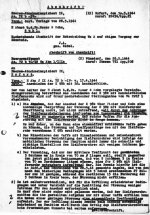Dug this out of NARA tonite when looking for material for V4.
Approx. translation:
Army Acceptance Inspector IX,(15) Erfurt, May 30, 1944 Call: 22436/Ext. 21
from May 28, 1944
H Abnet bad. Fa. Sauer & Sohn, Suhl,
The following copy of the decision Wa A on the above process for your information.
J.A. gez. Kezel.
Army Ordnance Office
Aπ. 72 6 30/42 Abn 1/IIIa (2) Wünsdorf, May 26, 1944 Call: Zossen 751 Ext. 508
Army Acceptance Inspector IX, Erfurt.
Subject: H Abn J IX Ref. 72 b-IV- dated April 17, 1944: Zeroing the K 98k with commercially available scope.
Re: The simplification proposal submitted by the head of the H Dept. b.C., Sauer & Sohn, regarding the sighting of the K 98k with a commercially available telescopic sight is rejected on the basis of the following statement by Wa Prüf 1.
1a. The assumption that sighting the K 98k via the rear sight and front sight makes a repeated check of the dispersion of the K 98k with a telescopic sight unnecessary is incorrect, because attaching the telescopic sight mount (occurrence of tension) sometimes makes the dispersion so unfavorable that such weapons are not suitable for equipping with a telescopic sight. Therefore, in order to provide the operator with a perfectly firing weapon, the dispersion and point of impact of the K 98k equipped with the telescopic sight must be determined
b) Zeroing the weapon with single shots and, in between, progressively adjusting the telescopic sight will not always ensure quick and correct adjustment of the telescopic sight with just a few shots due to the natural dispersion of the ammunition.
c) The suggestion that only the mean point of impact of the three shots fired should be in a circle of 70 mm in diameter represents an unacceptable widening for the K 98k with a telescopic sight compared to the currently valid conditions that three out of five shots must be in a circle of 70 mm in diameter. Proof of this is the statement in paragraph 4 of the letter dated March 28, 1944 that of the 27 targets fired with five shots under the previous conditions, only 12 meet the requirements, while the remaining 15 do not meet the requirement of three shots in a circle or dispersion.
2) It goes without saying that, in order to fulfill the simplified conditions and to forego the determination of the dispersion, fewer cartridges are required for the shot. However, it must not be forgotten that the riflescope shooter can only fulfill the tasks assigned to him with a weapon that has a flawless point of impact despite a low dispersion. The additional ammunition required to fulfill this purpose is compensated for by the riflescope shooter's success in front-line operations at long range.
B.
Approx. translation:
Army Acceptance Inspector IX,(15) Erfurt, May 30, 1944 Call: 22436/Ext. 21
from May 28, 1944
H Abnet bad. Fa. Sauer & Sohn, Suhl,
The following copy of the decision Wa A on the above process for your information.
J.A. gez. Kezel.
Army Ordnance Office
Aπ. 72 6 30/42 Abn 1/IIIa (2) Wünsdorf, May 26, 1944 Call: Zossen 751 Ext. 508
Army Acceptance Inspector IX, Erfurt.
Subject: H Abn J IX Ref. 72 b-IV- dated April 17, 1944: Zeroing the K 98k with commercially available scope.
Re: The simplification proposal submitted by the head of the H Dept. b.C., Sauer & Sohn, regarding the sighting of the K 98k with a commercially available telescopic sight is rejected on the basis of the following statement by Wa Prüf 1.
1a. The assumption that sighting the K 98k via the rear sight and front sight makes a repeated check of the dispersion of the K 98k with a telescopic sight unnecessary is incorrect, because attaching the telescopic sight mount (occurrence of tension) sometimes makes the dispersion so unfavorable that such weapons are not suitable for equipping with a telescopic sight. Therefore, in order to provide the operator with a perfectly firing weapon, the dispersion and point of impact of the K 98k equipped with the telescopic sight must be determined
b) Zeroing the weapon with single shots and, in between, progressively adjusting the telescopic sight will not always ensure quick and correct adjustment of the telescopic sight with just a few shots due to the natural dispersion of the ammunition.
c) The suggestion that only the mean point of impact of the three shots fired should be in a circle of 70 mm in diameter represents an unacceptable widening for the K 98k with a telescopic sight compared to the currently valid conditions that three out of five shots must be in a circle of 70 mm in diameter. Proof of this is the statement in paragraph 4 of the letter dated March 28, 1944 that of the 27 targets fired with five shots under the previous conditions, only 12 meet the requirements, while the remaining 15 do not meet the requirement of three shots in a circle or dispersion.
2) It goes without saying that, in order to fulfill the simplified conditions and to forego the determination of the dispersion, fewer cartridges are required for the shot. However, it must not be forgotten that the riflescope shooter can only fulfill the tasks assigned to him with a weapon that has a flawless point of impact despite a low dispersion. The additional ammunition required to fulfill this purpose is compensated for by the riflescope shooter's success in front-line operations at long range.
B.
Attachments
Last edited:


